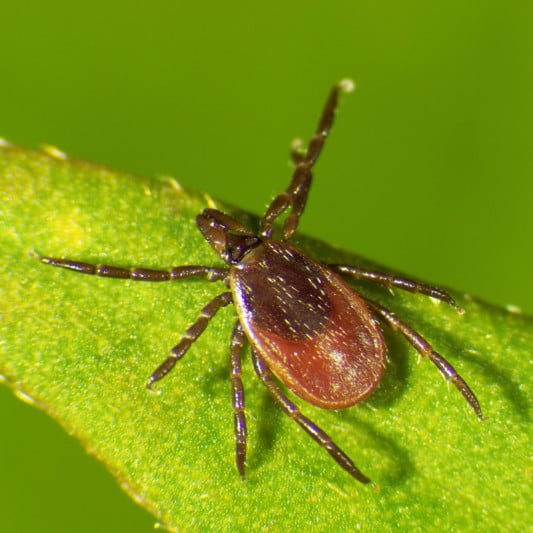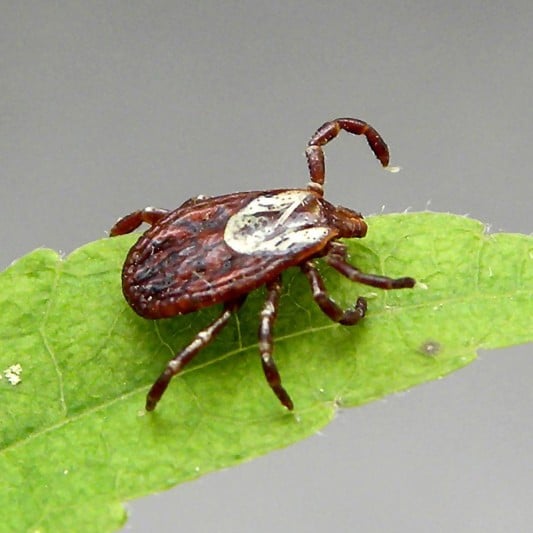(SPEECH)
[00:00:00.00] [MUSIC PLAYING]
(DESCRIPTION)
[00:00:00.00] Logo, LL Bean. a drawing of a tick. Text, tick prevention tips. Garrick, L.L. Bean customer and outdoor lover. A young man enters and sets his backpack on a hook. He stands behind a counter with outdoor gear and insect repellent cans.
(SPEECH)
[00:00:02.76] Hi, I'm Garrick. I love to spend time outside. But I do not love dealing with bugs. As important as these little guys and gals are, I don't want them on me, especially ticks which can carry Lyme and other diseases. And when it comes to tick prevention tips, I go to the experts. Speaking of experts, hi, Maddie.
[00:00:20.58] Hi, Garrick.
[00:00:21.33] Why
(DESCRIPTION)
[00:00:21.33] Maddie enters and gives Garrick a high five. Text, Maddie, outdoor discovery programs instructor.
(SPEECH)
[00:00:21.45] don't you introduce yourself?
[00:00:22.75] My name is Maddie. I'm an instructor with LL Bean's Outdoor Discovery Programs. So I have a lot of experience getting people comfortable in the outdoors.
[00:00:30.69] Great, let's get to it.
(DESCRIPTION)
[00:00:32.58] A person dressed as a tick spins around and accidentally bumps into the microphone boom. Text, gear to avoid ticks. A light jacket with a tan outer shell.
(SPEECH)
[00:00:33.97] So Maddie, what's special about these clothes?
[00:00:36.69] Well, Garrick, you might be able to keep ticks off of you by wearing tick repellent clothing. It's so easy. You simply put on the clothes. And that can help to deter or kill ticks before they get to your skin.
[00:00:47.28] Cool, so how does that work?
[00:00:49.48] Well, these LL Bean Insect Shields and No Fly Zone clothes have Permethrin. Permethrin is a synthetic version of a natural bug repellent that's produced by chrysanthemums. And it's built right into the fabric. It's an effective bug repellent. And it can last for up to 70 washings. You can spray Permethrin on clothing yourself, following all the instructions and warnings on the label. But you have to be diligent. It can be hard to apply it evenly. And it won't last as long as the factory-treated clothing.
[00:01:17.84] [MUSIC PLAYING]
(DESCRIPTION)
[00:01:17.87] The person dressed as a tick approaches the counter and pushes the clothing onto the floor cautiously.
(SPEECH)
[00:01:22.15] These look like they'll keep out a lot of bugs.
[00:01:24.63] Yeah, exactly. When you're choosing clothing you want to go for long sleeves and long pants. The less exposed skin, the better. You should also consider light colored clothing because it will be easier to see the ticks.
[00:01:34.78] OK, and for any skin that you can't cover?
[00:01:37.83] You're going to want to use insect repellent. The CDC recommends using EPA-registered insect repellents with any of these ingredients: DEET, picaridin, IR3535, oil of lemon eucalyptus, para-menthane-diol, or 2-undecanone.
(DESCRIPTION)
[00:01:56.69] The tick sprays one of the cans and drops it immediately.
(SPEECH)
[00:01:58.51] OK, so that's long sleeves, pants, insect repellent clothing, and insect repellent.
[00:02:05.10] You got it. Combine all of those pieces of gear together, and you should have a pretty good shield against ticks and other bugs.
[00:02:11.04] Right on. Let's gear up!
(DESCRIPTION)
[00:02:13.24] They jump and now they are wearing the tick repellent clothing.
(SPEECH)
[00:02:14.19] So we're ready to head outside, right?
[00:02:15.84] Almost. Your tick repellent clothing is going to be a lot more effective if the ticks can't get up underneath it. So when you're heading outside, you want to tuck your pants into your socks. You can also take your long sleeves and pull the cuff up your forearm so it's nice and tight.
[00:02:30.93] [MUSIC PLAYING]
(DESCRIPTION)
[00:02:30.94] The tick finds a sign that says tic habitat and pulls it out surreptitiously.
(SPEECH)
[00:02:34.94] OK, so this clothing and spray can deter ticks from getting on us. But how do we avoid running into ticks in the first place?
[00:02:42.03] Well, ticks love areas like brush, tall grasses, leaf litter, and overgrown trails.
(DESCRIPTION)
[00:02:48.26] A metal pot with tall grasses. A collection of dried leaves.
(SPEECH)
[00:02:48.62] So it's best to avoid those places and stay on the mowed, clear trails so they have fewer places to hide.
(DESCRIPTION)
[00:02:55.04] Text, do a tick check.
(SPEECH)
[00:02:56.00] Every time you go inside, you should do a full check on yourself and your pets as soon as possible. Make sure that you pay close attention to some of ticks' favorite hiding spots like in your hair, behind your ears, around your waist, and behind your knees.
[00:03:11.28] So what am I looking for in a tick check? What do ticks actually look like?
[00:03:15.03] Well, there's many different types of ticks. A few that commonly bite humans are the black-legged or deer tick. It's
(DESCRIPTION)
[00:03:21.73] Images of ticks.
(SPEECH)
[00:03:22.04] an orange brown with dark legs and about an 1/8 of an inch long. We also have the Lone Star ticks. They're reddish brown. They have a white dot on their back. And they're about a quarter of an inch long. And lastly, there's the American dog ticks. They're model dark brown. They're flat and oval and about a quarter of an inch long.
[00:03:41.81] Ugh, I don't want any of those on me. What do I do if I find one?
[00:03:45.74] Well, if you find one on you that hasn't bitten you yet, you can simply go outside and brush it off.
[00:03:51.54] And if it has bitten me?
[00:03:53.66] Ticks can be easy to remove with fine tip tweezers. For specific instructions on how to identify and remove ticks and for more information about ticks and tick-borne diseases, you can visit the Centers for Disease Control and Prevention's website, at cdc.gov/ticks.
(DESCRIPTION)
[00:04:10.29] A sign in the brush that reads warning tick habitat.
(SPEECH)
[00:04:12.95] For more outdoor tips, visit our Get Outside Guide at llbean.com/outside. We'll see you out there.
[00:04:20.57] [MUISC PLAYING]
(DESCRIPTION)
[00:04:22.00] The tick hides behind the pot of tall grass and shuffles back-and-forth in front of the camera..
(SPEECH)
[00:04:24.87] Premiumbeat.com
[00:04:25.18] [MUSIC PLAYING]
[00:04:26.69]
<We love spending time outside, but we do not love dealing with bugs – especially ticks, which can carry Lyme and other diseases. Here are some easy tips and gear recommended by the University of Maine Tick Lab covering all the basics: gear that can help you avoid ticks, tips to avoid ticks when you're outside, how to identify common ticks, and what to do if you find a tick on you.
Gear to Avoid Ticks
INSECT-REPELLENT CLOTHING
You can also spray permethrin on clothing yourself, following the directions and warnings on the label, but you have to be diligent – it's tough to spread the spray evenly, and the protection won’t last as long as factory-treated clothing.
PERMETHRIN SPRAY
You can also spray permethrin on clothing yourself, following the directions and warnings on the label, but you have to be diligent – it's tough to spread the spray evenly, and the protection won’t last as long as factory-treated clothing.
LONG SLEEVES AND PANTS & LIGHT-COLORED CLOTHING
When choosing clothing, go for long sleeves and pants – the less exposed skin, the better. You should also pick light-colored clothing, since it can make ticks easier to spot.
INSECT REPELLENTS
For any exposed skin that you can’t cover, you should protect it with insect repellent. The CDC recommends using EPA-registered insect repellents containing any of these ingredients:
- DEET
- Picaridin
- IR3535
- Oil of lemon eucalyptus
- Para-menthane-diol
- 2-undecanone
Tips to Avoid Ticks and Tick Bites
TUCK YOUR PANTS INTO YOUR SOCKS & PULL YOUR LONG SLEEVES TIGHT
Your tick-repellent clothing is going to be a lot less effective if ticks can just get underneath it, so when you head outdoors, it’s a good idea to tuck your pants into your socks, and pull your long sleeves up so the cuffs are tight around your forearms.
AVOID OVERGROWN AREAS
Ticks love areas like brush, tall grass, leaf litter and overgrown trails, so it’s best to avoid those areas and stay on mowed or cleared trails where there are fewer places for ticks to hide.
GO OUT AT DRY TIMES
You can lower your chances of encountering ticks by putting on your sun protection and going out on the hottest, driest parts of the day.
DO A TICK CHECK WHEN HEADING INDOORS
Every time you head indoors, you should do a full tick check on yourself and any pets as soon as possible. Be sure to double-check ticks’ favorite hiding spots, like:
- Under your arms
- Around your ears
- Behind your knees
- Around your waist
- In your hair
How to Identify Common Ticks
A few ticks that commonly bite humans are:

Blacklegged (or "deer") ticks. Orange brown, with dark legs, about 1/8 of an inch long.

Lone star ticks. Reddish brown, with a white dot on their back, about 1/4 of an inch long.

American dog ticks. Mottled dark brown, flat and oval, about 1/4 of an inch long.
What to Do if You Find a Tick on You
If you find a tick that hasn’t bitten you yet, you can simply brush it off outside.
If you find a tick that has bitten you and is attached, it should be easy to remove with a pair of fine-tipped tweezers.
For specific instructions about how to identify and remove ticks – and more information about ticks and tick-borne disease – visit the Centers for Disease Control and Prevention’s website at www.cdc.gov/ticks.
Now that you know how to get out there safely, complete your outdoor outfit with bug-repellent clothing , sturdy men's footwear, women's footwear, and expert-tested outdoor equipment.
Explore the Get Outside Guide for more tips and how-tos, like our tips for camping with dogs, our guide to hiking and ideas for creating the perfect outdoor reading spot in your backyard.


